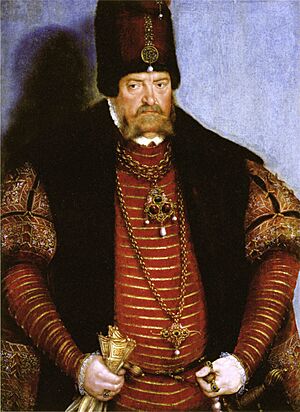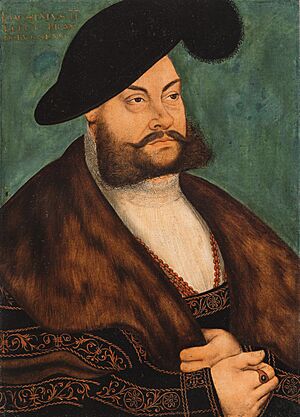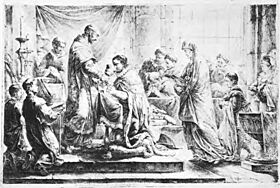Joachim II Hector facts for kids
Quick facts for kids Joachim II Hector |
|
|---|---|

Joachim II Hector, Elector of Brandenburg. By Lucas Cranach the Younger, 1570
|
|
| Elector of Brandenburg | |
| Reign | 11 July 1535 – 3 January 1571 |
| Predecessor | Joachim I Nestor |
| Successor | John George |
| Born | 13 January 1505 Cölln, Margraviate of Brandenburg, Holy Roman Empire |
| Died | 3 January 1571 (aged 65) Köpenick Palace, Margraviate of Brandenburg, Holy Roman Empire |
| Spouse |
Magdalena of Saxony
(m. 1524; died 1534)Hedwig of Poland
(m. 1535) |
| Issue Detail |
|
| House | Hohenzollern |
| Father | Joachim I Nestor, Elector of Brandenburg |
| Mother | Elizabeth of Denmark, Norway, and Sweden |
| Religion | Lutheran (from 1539) Roman Catholic (until 1539) |
| Signature |  |
Joachim II (born January 13, 1505 – died January 3, 1571) was an important ruler in Germany. He was a Prince-elector of Brandenburg from 1535 to 1571. This meant he was one of the powerful princes who helped choose the Holy Roman Emperor. Joachim II was the sixth ruler from the House of Hohenzollern, a famous German royal family.
He was the oldest son of Joachim I Nestor, Elector of Brandenburg and his wife Elizabeth of Denmark, Norway, and Sweden. People called him Hector because they thought he was brave and strong, like the famous Trojan prince and warrior from ancient stories.
Contents
Becoming a Ruler and Early Life

Joachim II was born in a city called Cölln. He grew up learning at the imperial court, which was like a school for young nobles. His father, Joachim I Nestor, made him sign a special agreement. In this agreement, Joachim II promised to stay Catholic.
This promise was important for his father's younger brother, Albert of Mainz. Albert had borrowed a lot of money to become an archbishop and to hold several important church jobs at once. To pay back this money, Albert was allowed to sell "indulgences." These were special papers that people bought to reduce punishment for their sins.
Joachim II's father helped arrange this deal. If Joachim II hadn't agreed to stay Catholic, he might not have become the next ruler.
Religious Changes in Brandenburg
Joachim II's first wife was Magdalena of Saxony. She passed away in 1534. In 1535, he married Hedwig, whose father was King Sigismund I the Old of Poland. Hedwig's family was Catholic. Joachim II promised her father that Hedwig would not have to change her religion.
After his father died in 1535, Joachim II slowly started to support the Protestant Reformation. On November 1, 1539, he took Communion under both kinds. This was a Protestant practice and showed he was interested in the new religious ideas.
However, Joachim II did not officially become a Lutheran until 1555. He wanted to avoid problems with his powerful friend, Emperor Charles V. Before 1555, Joachim II made some changes to the church in Brandenburg. These changes followed Lutheran ideas but kept many old traditions, like having bishops and parts of the church service in Latin.
Bringing Jews Back to Brandenburg
In 1510, Jewish people had been forced to leave Brandenburg. This happened after false accusations that they had damaged holy items. In 1539, a Lutheran leader named Philipp Melanchthon told princes that these accusations were untrue.
A Jewish leader, Josel von Rosheim, asked Joachim II to let Jewish people return to Brandenburg. Joachim II agreed to this request on June 25, 1539. This was an important step towards allowing Jewish communities to live in the area again.
Joachim's Interests and Challenges
Joachim II loved hunting and spent a lot of money on exotic animals like lions, bears, and wolves. He even made them fight each other. He also hired many alchemists, who were people who tried to turn metals into gold.
Because of these expensive hobbies, Joachim II got into a lot of debt. His father had left the country's money in good shape, but by 1540, Joachim II owed a huge amount. To try and pay it off, he took over some church property and raised taxes.
Wars and Alliances
Joachim II's wife Hedwig was related to John Zápolya, who wanted to be king of Hungary. But Joachim II supported Ferdinand of Habsburg, who also claimed the Hungarian throne. Ferdinand was fighting against the Ottoman Empire, who were invading Hungary.
In 1542, Joachim II helped Ferdinand fight the Ottomans. He led an army from different countries, but he was not an experienced soldier. His army had to retreat, and he was defeated again by the Ottomans later that year.
In 1545, Joachim II held a big double wedding for two of his children. His son, John George, and his daughter, Barbara, both married children of Duke Frederick II of Legnica from Silesia. This helped strengthen alliances.
Joachim II was also a brother-in-law to King Sigismund II Augustus of Poland. In 1569, he made an agreement with Sigismund. This agreement said that Joachim and his children would inherit Ducal Prussia if the Hohenzollern family line there ever ended.
Joachim II passed away in 1571 at the Köpenick Palace, which he had built in 1558.
Family Life and Children
Joachim II had several children with his two wives.
With Magdalena of Saxony (1507–1534):
- John George, Elector of Brandenburg (1525–1598)
- Barbara of Brandenburg, Duchess of Brieg (1527–1595)
- Elisabeth (1528–1529)
- Frederick IV of Brandenburg (1530–1552), who became an Archbishop
- Albrecht (1532–1532)
- Georg (1532–1532)
- Paul (1534–1534)
With Hedwig Jagiellon (1513–1573):
- Elisabeth Magdalena (1537–1595)
- Sigismund (1538–1566), who also became an Archbishop
- Hedwig (1540–1602)
- Sophia (1541–1564)
- Joachim (1543–1544)




